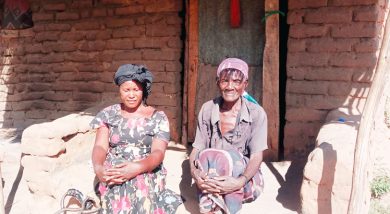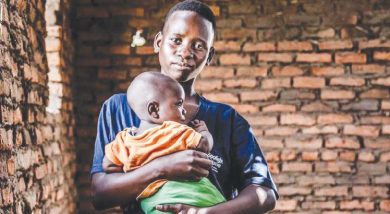Dealing with food insecurity the Kawerawera way
Visit the house of Masamba Tembo, 43, of Kaigwazanga Village in Traditional Authority (T/A) Mkanda in Mchinji with a story about this year’s fears of a looming hunger and hear what surprises you will get.
“Where is the hunger?” asks Tembo as if he is a stranger in Malawi. “There is no hunger in my house and it won’t even be there next year.”
Call it bragging, but that is the true story in Tembo’s household. While the majority of smallholder farmers are grappling with questions on how they will survive since their harvests were affected by the January floods, Tembo is busy thinking about investments. He had a different story about this year’s harvesting season, which was labelled the worst.
Like over 1 000 other smallholder farmers in his area, Tembo’s farm was not spared by the heavy downpour. But while other farmers surrendered to their fate after the rainstorm, Tembo, who is married and has five children, did not. He even ignored government’s instruction that farmers should not replant after the damage. He went ahead reworking on his farm.
Today, Tembo is the happiest farmer after producing almost half of his field’s annual output in favourable weather. Instead of 40 bags of maize, he harvested 21 alongside other food crops such as cassava, Irish and sweet potatoes.
Although his annual maize harvest has been halved, his food stock stands normal because he got additional food crops from the National Smallholder Farmers Association of Malawi (Nasfam) in-growers farm initiative.
This is a project in which Nasfam identifies land and helps farmers to practice commercial farming. They grow groundnuts and soya supervised by Nasfam extension workers. After harvest, Nasfam helps the farmers to sell for cash all the produce.
Tembo and other farmers in the surrounding communities are beneficiaries of the pilot project at the 750 hectares Kawerawera Farm, which was previously owned by Press Trust through Press Agriculture. It is located 20 kilometres from Mchinji Boma along Mkanda Road.
Nasfam chief executive officer Dyborn Chibonga says the farm was opened last year, as a pilot project, after appreciating that most smallholder farmers produce yields far below potential and are struggling to generate extra income from farming. He says the initiative is called ‘Rural production, marketing and processing hub’.
Journalists on a recent tour of the farm observed that work at the farm is still at infant stage and only crop production and marketing activities have started.
One hundred farmers farmers are already benefiting and the project’s concept says when the farm becomes fully operational, it could benefit 1 500 farmers. Each farmer is allocated half a hectare and Nasfam gives them inputs. Those growing soya and groundnuts are expected to pay back 75 kilogrammes and 100 kilogrammes respectively, after harvesting.
“The core concept is to allow small-scale farmers in the communities to work collectively on pieces of land under the supervision and training of our extension staff. The clustering of growers allows for huge efficiencies in the provision of extension services, which include all aspects of good agricultural practices,” explained Chibonga.
He added that clustering also allows for provision of quality seed and for farmers to access hired technologies and equipment. He said they are exploring options to allow smaller-scale farmers to handle larger portions of land. Once it passes, each farmer will be given up to 25 hectares of land.
Tembo is one of the farmers enrolled during the pilot year. He harvested 13 bags of soya from which he realised about K250 000.
“Without this project, I could not have harvested from my traditional farm because I relied on advice from extension workers at the hub. Some neighbours despite reworking on their farms after the floods realised poor yields,” said Tembo.
From his farming activities, Tembo has built an iron sheet-roofed four-bedroom house and also constructed a brick fence around his yard, an achievement he said he could not make in over 20 years he has been a farmer. He bragged that his children will attain better education and sees more investments in the coming harvesting season.
Also singing praise of the Nasfam initiative is Nellie Apunayere, 44, of Noti Village, T/A Kazyozyo in the same district. The January floods did not spare her farm. She harvested only four ox-cart loads of maize instead of nine and said the harvest is finished already. She also grew Nakwacha soya variety on her traditional farm and got four bags, but is failing to secure a better market because the variety is not preferred by buyers.
Apunayere would have been among the 2.8 million facing hunger this year as announced by government, had Nasfam not rolled out the in-growers initiative from which she has pocketed K220 000 from Nasfam’s Tikolore soya seed. She harvested nine bags.
“I bought a bicycle, 20 bags of maize and paid workers at my traditional farm. I have also paid school fees for my child who is in Form One. This seems to be an exit route from poverty for my family,” said the family head of four children.
Kawerawera farm manager Cosmas Kafwafwa said the initiative has benefited many farmers, citing Tembo as an example.
“This growing season we will have 300 farmers and 250 of them will grow soya while the rest will grow groundnuts,” said Kafwafwa, adding that farmers given land at Kawerawera Farm automatically become Nasfam member farmers.
Principal secretary in the Ministry of Agriculture, Water and Irrigation, Erica Maganga visited the farm recently and praised the initiative: “This extension model is a commendable effort we believe will go a long way in improving methods of delivering farmer advisory services in the country. It is also a catalyst for maximising land use and increasing yield per hectare, apart from helping farmers to have money. This is the direction to take as a country.”






